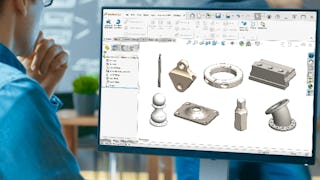This course focuses on the detection of features and boundaries in images. Feature and boundary detection is a critical preprocessing step for a variety of vision tasks including object detection, object recognition and metrology – the measurement of the physical dimensions and other properties of objects. The course presents a variety of methods for detecting features and boundaries and shows how features extracted from an image can be used to solve important vision tasks.

Enjoy unlimited growth with a year of Coursera Plus for $199 (regularly $399). Save now.

Features and Boundaries
This course is part of First Principles of Computer Vision Specialization

Instructor: Shree Nayar
5,001 already enrolled
Included with
(54 reviews)
Recommended experience
What you'll learn
Learn how to detect edges and corners in images.
Develop active contours (snakes) to find complex object boundaries.
Learn about the Hough Transform for finding simple parametric shapes in images.
Learn about image transformations and how to estimate the homography between two images.
Skills you'll gain
Details to know

Add to your LinkedIn profile
29 assignments
See how employees at top companies are mastering in-demand skills

Build your subject-matter expertise
- Learn new concepts from industry experts
- Gain a foundational understanding of a subject or tool
- Develop job-relevant skills with hands-on projects
- Earn a shareable career certificate

There are 6 modules in this course
What's included
8 readings2 discussion prompts8 plugins
What's included
2 readings6 assignments2 discussion prompts6 plugins
What's included
2 readings5 assignments2 discussion prompts5 plugins
What's included
1 reading5 assignments2 discussion prompts5 plugins
What's included
1 reading6 assignments1 discussion prompt6 plugins
What's included
3 readings7 assignments2 discussion prompts7 plugins
Earn a career certificate
Add this credential to your LinkedIn profile, resume, or CV. Share it on social media and in your performance review.
Instructor

Offered by
Explore more from Algorithms
 Status: Free Trial
Status: Free TrialColumbia University
 Status: Free Trial
Status: Free TrialColumbia University
 Status: Free Trial
Status: Free TrialDassault Systèmes
 Status: Free Trial
Status: Free TrialDassault Systèmes
Why people choose Coursera for their career




Learner reviews
54 reviews
- 5 stars
87.03%
- 4 stars
9.25%
- 3 stars
1.85%
- 2 stars
1.85%
- 1 star
0%
Showing 3 of 54
Reviewed on Jan 20, 2023
A little bit advanced, but the quality of the slides and presentations is superb.
Reviewed on Apr 27, 2022
Amazing course , Well explained and interesting assignments!!!
Reviewed on Dec 13, 2021
Another excellent course on first principles of comuter vision.
Frequently asked questions
To access the course materials, assignments and to earn a Certificate, you will need to purchase the Certificate experience when you enroll in a course. You can try a Free Trial instead, or apply for Financial Aid. The course may offer 'Full Course, No Certificate' instead. This option lets you see all course materials, submit required assessments, and get a final grade. This also means that you will not be able to purchase a Certificate experience.
When you enroll in the course, you get access to all of the courses in the Specialization, and you earn a certificate when you complete the work. Your electronic Certificate will be added to your Accomplishments page - from there, you can print your Certificate or add it to your LinkedIn profile.
Yes. In select learning programs, you can apply for financial aid or a scholarship if you can’t afford the enrollment fee. If fin aid or scholarship is available for your learning program selection, you’ll find a link to apply on the description page.
More questions
Financial aid available,





